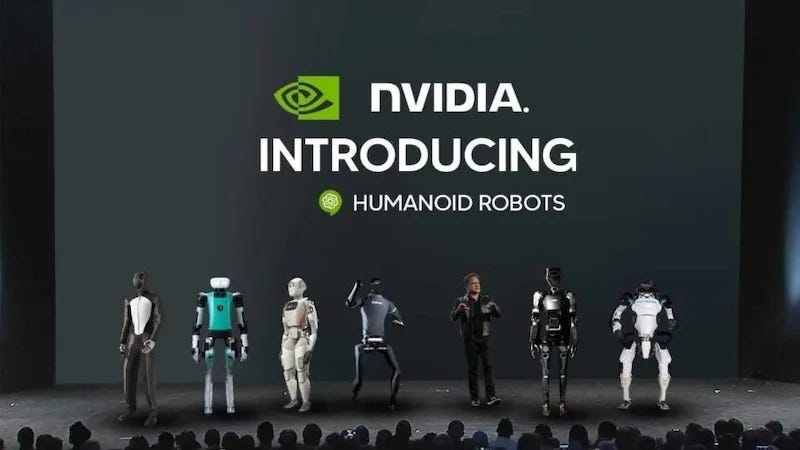AI: Robots in AI driven Food Services. RTZ #580
...an AI vertical with short term challenges, but long-term promise
Merry Christmas All!!
Today is a day we’re all going to indulge a bit in family celebrations and food. So thought a piece on AI and food might be on point.
I’ve written a lot about how Foundation Robotics, where LLM AIs power the next generation of robots, humanoid or otherwise, are the next frontier of AI innovation in this AI Tech Wave. Including investments by the leading AI companies today like Nvidia.
But robots are hard for a whole host of reasons beyond LLM AIs, which are software only. And although the goal long-term is to have general purpose robots that can be trained for specific consumer and business verticals, the reality is that for the near term, robots will also have to prove their value in specific verticals.
And for now there are opportunities, but also unique challenges by verticals. A good example is robots in the food service industry. The New York Times provides a deep dive in “Why Is It So Hard to Make a Robot Chef?”
“Restaurants are experimenting with automation.”
“But in the kitchen, human labor is hard to replace.”
“The robot revolution still has some kinks to work out, at least when it comes to cooking.”
“In recent years, restaurants have dabbled with ways to automate their operations. Labor typically eats up more than a quarter of restaurant chain revenues, so McDonald’s and Dunkin’ have installed kiosks where customers punch in their orders, reducing the number of cashiers. Others are looking to artificial intelligence programs for drive-through orders or inventory management.”
Restaurants big and small, are experimenting and deploying a whole host of AI powered robots. Some examples:
“Chipotle, where labor costs could reach $2.7 billion this year, or a quarter of its revenue, has been testing the Autocado, a machine that can cut, pit and scoop out an avocado in 26 seconds. White Castle has installed a system called Flippy to make fries and other items in 18 locations in the United States.”
“And Sweetgreen, the fast-casual salad chain, will have an automated salad-making system, the Infinite Kitchen, in about a dozen of its 240 restaurants by the end of this year.”
“But despite high interest in robots in the kitchen and years of efforts, they have yet to take off.”
Many of the challenges are counter-intuitive at first:
“Unlike car factories or Amazon warehouses, which rely on robots to perform repeatable actions, restaurant kitchens run on multitasking. Flipping pancakes requires a different system from one that dispenses coffee or makes spaghetti. Moreover, producing potentially sticky, gooey or cheesy foods means robots need to be easy to clean to maintain food-safety standards.”
“Steve Ells, who founded Chipotle in the 1990s, is trying to create “the platform of the future for the restaurant industry” at Kernel.”
And business model issues, like company owned restaurants vs franchise models matter, primarily due to the steep upfront investments:
““These systems are largely bespoke,” said Sharon Zackfia, group head of consumer research at William Blair, rattling off reasons that robots won’t replace fry cooks and prep chefs anytime soon.”
“Moreover, while automated systems may reduce labor costs over time, many have a steep upfront price tag — typically six figures.”
“The restaurant has to have deep pockets,” Ms. Zackfia continued. But, she cautioned, “it has to be largely company-owned and not franchised.” At a chain like McDonald’s or Burger King, franchisees, who own most outlets, would have to bear the costs.”
“Nor is it easy to squeeze an automated system into already tight kitchens or retrofit an entire kitchen.”
“The kitchen, for now, is still mostly the human domain.”
The whole piece is worth reading for the short term challenges, and the longer term promise of robots in our eating establishments.
Unlike the Energy industry vertical we examined a few days ago, where the software only nature of applying AI made most of those applications relatively easier to scale, both as ‘AI add-ons’ and ‘AI-native’ software innovations, the hardware/software combinations of these robots, make the eventual payoffs harder to ramp, attain and sustain.
But as this AI Tech Wave develops further over the years, look for more robots to do more than take orders at the counter and the drive through. Stay tuned.
And again, the Best wishes this Christmas to you and yours.
(NOTE: The discussions here are for information purposes only, and not meant as investment advice at any time. Thanks for joining us here)






